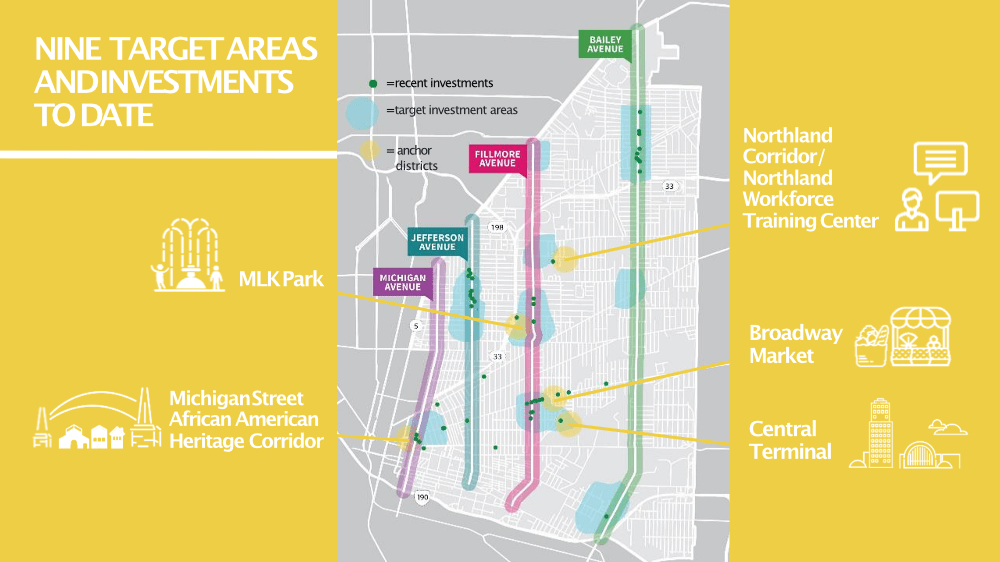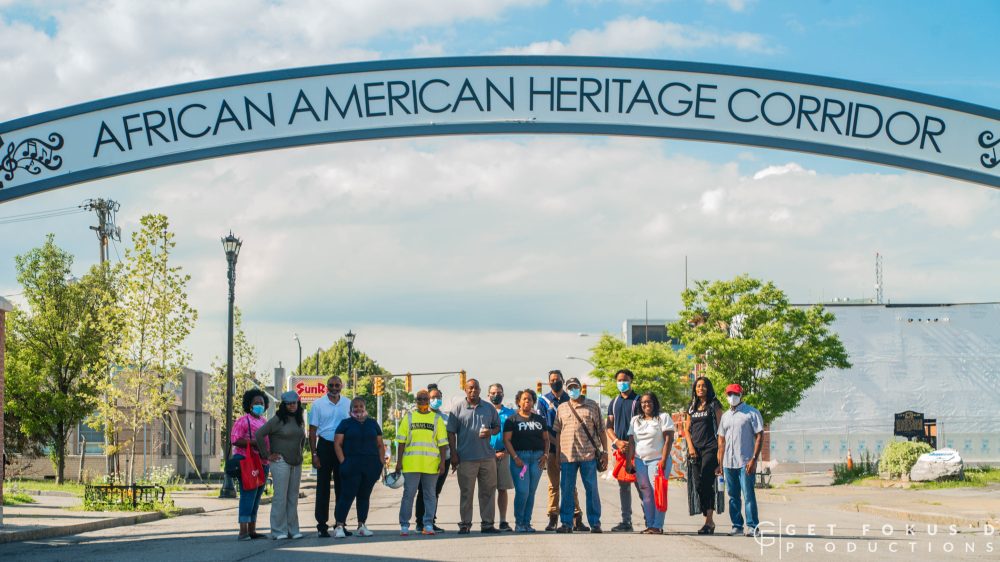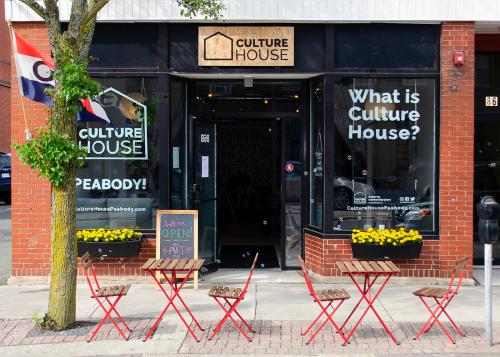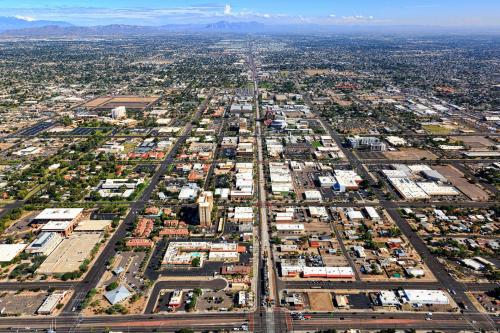Placemaking Postcards is a blog series from the Bass Center for Transformative Placemaking at Brookings where policymakers and practitioners guest-author promising placemaking efforts from across the U.S. and abroad that foster connected, vibrant, and inclusive communities. In line with the principle tenets of placemaking, the goal of the series is to recognize the community as the expert, highlight voices from the field, and to create a community of learning and practice around transformative placemaking.
In 2018, the state of New York committed an unprecedented investment—$65 million—to a new place-based initiative to revitalize Buffalo’s East Side. There is perhaps no place in the region where wealth generation is more important: People of color make up 80% of the East Side’s population, and decades of disinvestment have left residents with limited opportunities for economic mobility.[1]
Our team at the University at Buffalo Regional Institute (UBRI) became involved in the initiative, knowing we had to keep our promises to a place that had been overlooked and underserved for too long. This was a major investment opportunity and needed to be undertaken differently than what was done in the past. Most notably, the community’s voice and vision had to be at the heart of the change.
Leveraging state, private, and philanthropic investment in targeted areas
Buffalo’s East Side is characterized by significant structural obstacles to growth as well as significant potential. Ninety-five percent of the population lives in a neighborhood of concentrated poverty. Of the nearly 70,000 working-age adults, over 30,000 are unemployed or out of the labor force.[2] But with 1,650 acres of vacant land and 850 vacant commercial addresses concentrated around commercial corridors, there is substantial opportunity to plan for development that connects residents to opportunity.[3]
Part of the state’s Buffalo Billion Phase II strategy, the $65 million East Side Corridor Economic Development Fund was allocated to inspire transformational capital investments in nine target areas on the East Side (Figure 1). Seeing the opportunity to leverage and complement this state-led investment, 14 private and philanthropic organizations pooled an additional $8 million to support the operations, capacity-building, and community infrastructure needed to maximize community benefit from and ownership over the East Side’s revitalization.
The result, East Side Avenues brings together public and private funders, community-based organizations, consultants, and the city to plan and coordinate the many revitalization activities aimed at improving economic conditions on Buffalo’s East Side. Our role at UBRI is to lead implementation, reach out to community members, analyze past investments, and create a comprehensive plan focused on projects that are critical for promoting economic activity.
Figure 1. East Side Avenues’ nine target areas

Building a revitalization strategy starts with resident engagement
To determine what investments could shape the future of the nine target areas, the East Side Avenues planning team—consisting of UBRI and Empire State Development staffers—wanted to hear from residents first. We held four stakeholder meetings with hundreds of participants, accessible to each of the corridors on the East Side. Outreach was targeted but also inclusive—we reached out to nonprofit community associations, business associations, block clubs, and faith-based organizations.
Throughout this resident engagement process, no idea was a bad idea. There wasn’t some 20-page application; instead, we asked residents for one page that described an idea, how far along it was, and its cost. Anyone who submitted an idea was offered a listening session—a chance to informally share their vision with the planning team. Over 100 submissions came in and community members requested 42 listening sessions. It wasn’t “Shark Tank”—our team was there to listen and learn.
We met incredible people who shared their visions. One mixed-use building owner dreamt of a new coffee shop; a beautician imagined a first-floor shared business space and upstairs apartments; and a family wanted to transform their business into an incubator for entrepreneurs. Patterns emerged from the conversations: Residents felt that community anchors and historic places were critical to the neighborhood’s success. Property and small business owners had great ideas but needed help implementing them. It would take a mix of new training opportunities, access to capital, and strengthening community assets to achieve their goals.
But when we began to talk about millions of dollars of investment, concerns about displacement also emerged. We needed to ensure the success of East Side community members and give them opportunities to build and grow on their own terms.
A five-part initiative to build community power and ownership
Based on the patterns of need that emerged from our conversations with the community and partnerships with nonprofit community-based organizations, we designed five strategic programs to address the East Side’s capacity gaps and fuel inclusive economic growth. These strategic programs include funding to:
- Renovate buildings in East Side commercial corridors
- Stabilize historic buildings at risk of further deterioration or future demolition
- Transform a predominantly Black corridor into a unified tourist destination
- Reactivate the historic Central Terminal
- Provide training for East Side residents and building owners in commercial real estate development while increasing access to capital
Over the next five years, we will expand the capacity of existing community-based nonprofits to implement all five programs and ensure work is driven by community priorities.
Resident developers are a building block of community ownership
Of the five programs above, the final one—the Community-Based Real Estate Development Training program (CBREDT)—is emblematic of how residents, businesses, and property owners can be empowered to invest in their own assets, start or expand their own businesses, and grow wealth.
The first of its kind in the region, we developed CBREDT as a tuition-free, non-credit-bearing, 23-week adult education program that provides East Side residents and building owners with an overview of commercial real estate development (including predevelopment, construction, and project financing), offers weekly lectures and hands-on activities by local professionals, connects students with mentors, and guides students toward a final project presented to a panel of jurors. The program is modeled off of other training programs like LISC’s ACRE program in Milwaukee and the University at Buffalo’s Real Estate Development program, but tailored based on input from a local workgroup of partners consisting of LISC Western New York, the city of Buffalo, potential program participants, existing East Side developers, community development corporations, and faith-based organizations.
We received 154 applicants, with 20 applicants each accepted into our first two cohorts. Largely due to COVID-19-related complications, 15 students completed the program in 2020 and 19 in 2021.
“This is an opportunity for people to learn about their city and East Side revitalization efforts and for people of color to advance to the next level.”
Leah Angel Daniel, 2021 CBREDT graduate
Our ultimate goal is to give East Side building owners and community members the know-how to undertake a commercial redevelopment project. We wanted to ensure revitalization is driven by the community, and buildings don’t sit unused or fall into the hands of absentee landlords or speculators. To bolster participants’ chances at success, Empire State Development established a $5 million fund to provide program graduates access to much-needed capital. Many students are moving forward with their projects, including building out space for a small business, renovating a family-owned 2,000-square-foot, three-unit property, and pursuing historic tax credits for a 90,000-square-foot mixed-use facility.
We’re planning a third CBREDT cohort for early 2022. We also offer continuing education and networking opportunities to graduates and check in on their development projects and readiness to apply for funding.
“This program made me confident that I can truly be a commercial developer. I feel privileged to have been a part of this incredible learning experience and to have connected with so many talented professionals.”
Brandi Barrett, 2020 CBREDT Graduate
Starting and ending with community voices
From the outset, East Side Avenues committed to elevating the voices of the community. And the best way to hear about a program’s results is directly from participants, so we continue to share CBREDT participants’ stories and promote their visions to inspire others.
East Side Avenues starts and ends with community voices, and is fueled by collaborative multiyear support from Empire State Development and 14 private funders to ensure we have the resources to succeed. We built the model together, are implementing it together, and continue to grow the economy, learn, problem-solve, and scale together.

Editor’s Note: For more info on content related to Community Ownership of Real Estate, please visit our page here.








Commentary
How Buffalo’s East Side Avenues is training citizen developers to revitalize commercial corridors
December 6, 2021